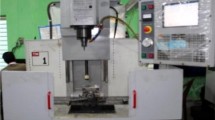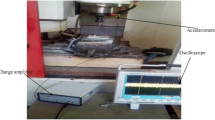Abstract
The study aims at design and development of an integrated system to model and optimize the cutting parameters for identifying and controlling the parameters so as to achieve high level performance and quality in the 2.5 D end milling process. Taguchi’s method is used for experimental design to find out the critical parameters in the 2.5 D end milling process. An optimized artificial neural network (ANN) based on feed-forward back propagation was used to establish the model between 2.5 D end milling parameters and responses. Genetic algorithm (GA) was utilized to find the best combination of cutting parameters providing lower temperature rise in the work piece (Al 6061 T6). As fitness function of GA the output of ANN is used in the study. Cutting parameters include speed, feed, depth of cut and step over. Parameters found out by GA were able to lowers the minimum temperature rise from 19.7 to 17.2 °C with almost 13% decrease. Both the modeling and optimization process was found satisfactory. Also the GA has emerged as an effective tool to optimize 2.5 D end milling process parameters.





Similar content being viewed by others
References
Abukhshim NA, Mativenga PT, Sheikh MA (2006) Heat generation and temperature prediction in metal cutting: a review and implications for high speed machining. Int J Mach Tools Manuf 46:782–800
Arrazola PJ, Ozel T, Umbrello D et al (2013) Recent advances in modelling of metal machining processes. CIRP Ann Manuf Technol 62(2):695–718
Barrow G (1973) A review of experimental and theoretical techniques for assessing cutting temperatures. Ann CIRP 22(2):203–211
Brinksmeier E, Minke E, Nowag L (2003) Residual stresses in precision components. In: Proceedings of the 5th international conference on industrial tooling, Southampton, 10–11 Sep, pp 1–21
Canakci A, Ozsahin S, Varol T (2012) Modeling the influence of a process control agent on the properties of metal matrix composite powders using artificial neural networks. Powder Technol 228:26–35
Canakci A, Erdemir F, Varol T et al (2013) Determining the effect of process parameters on article size in mechanical milling using the Taguchi method: measurement and analysis. Measurement 46(9):3532–3540
Christos S, Dimitrios S Neural networks. http://www.emsl.pnl.gov:2080/docs/cie/neural/neural.homepage.html
Feng SC, Hattori M (2000) Cost and process information modelling for dry machining. In: Proceedings of the international workshop for environment conscious manufacturing—ICEM-2000
Ghorbanian J, M Ahmadi, Soltani R (2011) Design predictive tool and optimization of journal bearing using neural network model and multi-objective genetic algorithm. Sci Iran B 18(5):1095–1105
Goldberg DE (1989) Genetic algorithms in search, optimization and machine learning. Addison-Wesley, Boston
Gupta AK, Chandna P, Tandon P (2011) Hybrid genetic algorithm for minimizing non productive machining time during 2.5 D milling. J Eng Sci Technol 3(1):183–190
Holland J (1975) Adaptation in natural and artificial systems. University of Michigan Press, Ann Arbor
Hou TH, Chen SH, Lin TU et al (2006) An integrated system for setting the optimal parameters in IC chip-package wire bonding processes. Int J Adv Manuf Technol 30:247–253
Komanduri R, Hou ZB (2001) Thermal modelling of the metal cutting process—part III: temperature rise distribution due to the combined effects of shear plane heat source and the tool-chip interface frictional heat source. Int J Mech Sci 43:89–107
Kumar D, Gupta AK, Chandna P, Pal M (2015) Optimization of neural network parameters using Grey-Taguchi methodology for manufacturing process applications. Proc IMechE Part C J Mech Eng Sci 229(14):2651–2664
Lazoglu I, Bugdayci B (2014) Thermal modelling of end milling. CIRP Ann Manuf Technol 63(1):113–116
Lee JA, Almond DP, Harris B (1999) The use of neural networks for the prediction of fatigue lives of composite materials. Compos A Appl Sci Manuf 30(10):1159–1169
Lin J (1995) Inverse estimation of the tool-work interface temperature in end milling. Int J Mach Tools Manuf 35:751–760
Michalewicz Z (1999) Genetic algorithms + data structures = evolution programs. Springer, Berlin
Nicholas JR (2003) Formal analysis and random respectful recombination. In: EPCC-TR-91-02 proceedings of the fourth international conference on genetic algorithms, 2003
Rahman MM (2014) Development of speech recognition system for continuous Bangla speech. Ph.D, Jahangirnagar University, Bangladesh
Rahman MM, Setu TA (2015) An implementation for combining neural networks and genetic algorithms. IJCST 6(3):218–222
Rech J, Arrazola PJ, Claudin C et al (2013) Characterization of friction and heat partition coefficients at the tool-work material interface in cutting. CIRP Ann Manuf Technol 62(1):79–82
Ross PJ (1988) Taguchi techniques for quality engineering. McGraw-Hill, New York
Roy R (1990) A primer on the taguchi method. Van Nostrand, New York
Shen GE, Arci O, Gandhi A et al (2001) A model for workpiece temperatures during peripheral milling including the effect of cutting fluids. In: NAMRC XXIX conference, Gainesville, Florida, MR01-269, 22–27 May, pp 1–8
Sinha A, Sikdar S, Chattopadhyay PP et al (2013) Optimization of mechanical property and shape recovery behavior of Ti-(49 at.%) Ni alloy using artificial neural network and genetic algorithm. Mater Des 46:227–234
Soltanali S, Halladj R, Tayyebi S et al (2014) Neural network and genetic algorithm for modeling and optimization of effective parameters on synthesized ZSM-5 particle size. Mater Lett 36:138–140
Soremekun G, Gürdal Z, Haftka RT et al (2001) Composite laminate design optimization by genetic algorithm with generalized elitist selection. Comput Struct 79(2):131–143
Sreejith PS, Ngoi BKA (2000) Dry machining: machining of the future. J Mater Process Technol 101:287–291
Talbi EG (2009) Metaheuristics: from design to implementation. Wiley, Hoboken
Theodorios S, Koutroumbas K (1999) Pattern recognition. Academic Press, Cambridge
Van Luttervelt CA, Childs THC, Jawahir IS et al (1998) Present situation and future trends in modelling of machining operations. In: Progress report of the CIRP working group ‘modelling of machining operations’ CIRP Annals—Manufacturing Technology, vol 47, No 2, pp 587–626
Yanxi Z, Xiangdong G, Seiji K (2015) Weld appearance prediction with BP neural network improved by genetic algorithm during disk laser welding. J Manuf Syst 34:53–59
Zeidi JR, Javadian N, Moghaddam RT et al (2013) A hybrid multi-objective approach based on the genetic algorithm and neural network to design an incremental cellular manufacturing system. Comput Ind Eng 66:1004–1014
Author information
Authors and Affiliations
Corresponding author
Ethics declarations
Conflict of interest
The authors declare that they have no conflict of interest.
Rights and permissions
About this article
Cite this article
Kumar, D., Chandna, P. & Pal, M. Efficient optimization of process parameters in 2.5 D end milling using neural network and genetic algorithm. Int J Syst Assur Eng Manag 9, 1198–1205 (2018). https://doi.org/10.1007/s13198-018-0737-6
Received:
Revised:
Published:
Issue Date:
DOI: https://doi.org/10.1007/s13198-018-0737-6




